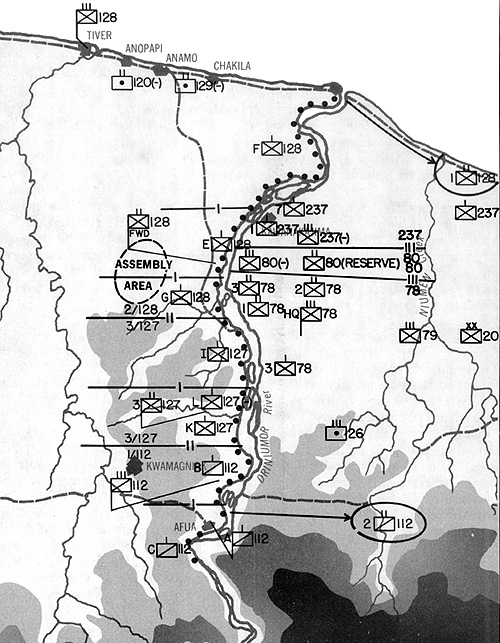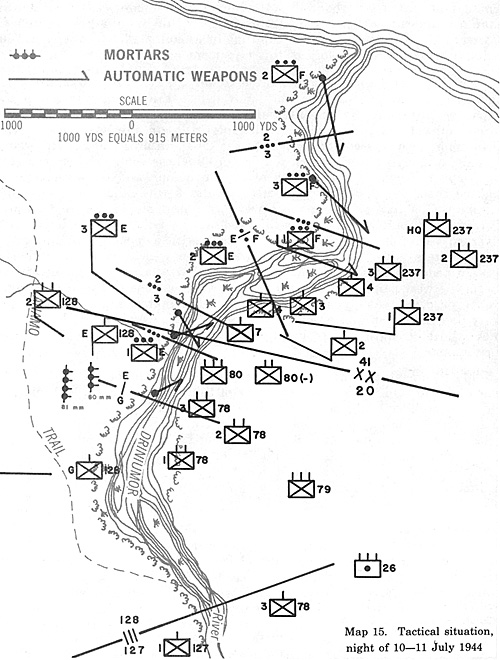 While General Adachi urged on his tired men with his fiery instructions on 6 July, General Krueger decided to preempt the anticipated Japanese attack with a reconnaissance in force, which would make the Japanese reveal themselves so that Krueger might crush them with a counterattack. He knew from Ultra sources that the Japanese were near the Driniumor and preparing to attack. American patrols from the 127th Infantry, 112th Cavalry, or 128th Infantry, however, had been unable to penetrate the Japanese infantry screen that shielded the exact whereabouts of 18th Army's
formations. To break through this blind, Krueger ordered a reconnaissance in force along the northern and southern flanks of the Driniumor covering force.
While General Adachi urged on his tired men with his fiery instructions on 6 July, General Krueger decided to preempt the anticipated Japanese attack with a reconnaissance in force, which would make the Japanese reveal themselves so that Krueger might crush them with a counterattack. He knew from Ultra sources that the Japanese were near the Driniumor and preparing to attack. American patrols from the 127th Infantry, 112th Cavalry, or 128th Infantry, however, had been unable to penetrate the Japanese infantry screen that shielded the exact whereabouts of 18th Army's
formations. To break through this blind, Krueger ordered a reconnaissance in force along the northern and southern flanks of the Driniumor covering force.
Moreover, General MacArthur's pressure on Krueger "to hurry up and get
through this New Guinea thing" caused a ripple effect throughout the command. Each subordinate commander in turn found himself subjected to orders "to get the job done." Thus, while Generals Gill and Martin
wanted to delay the reconnaissance, Krueger and Hall, anxious to please MacArthur and
to end the campaign, insisted that the operation go forward.
[26]
In the north, the 1st Battalion, 128th Regiment, drew the assignment, and in the south, the 2d Squadron, 112th Cavalry, was designated (see map 14). On 9 July at 1700, General Martin ordered 2d Squadron to move forward on the following morning to the Harech River, 7.7 kilometers east of Afua. This operation required, in turn, a redisposition of U.S. forces to cover the positions about to be vacated. Troop A, 1st Squadron, would replace the 2d Squadron.
At 1700 Troop A departed and took a little more than an hour to cover the two plus miles from River X to Afua. They had to move rapidly to reach Afua before nightfall, for after dark anything moving was considered unfriendly and likely to be shot. Commanders simply expected that Troop A would cover the distance and be in position to guard Afua until the rest of the regiment could reach them next morning. In the unthinkable event that Troop A did not carry out its mission, the entire south flank of Persecution Task Force's covering force would be exposed to Japanese envelopment.
At 0730 the next day, the remainder of the 112th Cavalry set off for Afua in a long column, Troop B leading and Troop C bringing up the rear. Thirty-minute intervals between each of the six units* in the order of march stretched the column almost the length of the march.
It took the command group nearly three hours to reach Afua. As soon as they arrived, 2d Squadron began to move forward to conduct its lonely mission. First Squadron prepared its defenses with Troop A on the right, Troop B to the left, and Troop C behind the Squadron Command Post located at Afua. Regimental Headquarters and the Weapons Troop moved about 1,400 meters north, nearer task force headquarters.
Meanwhile, the 2d Squadron underwent its own ordeal. After fording the
Driniumor, the men had to hack and cut their way with machetes through the thick jungle vegetation. They were moving in the deep jungle, where no sunlight broke through the canopy and where the stench of rotting vegetation and human sweat filled their nostrils. Even more lonely was a Troop G platoon that had to move parallel and about one kilometer South of the main
column in order to provide flank security. To the physical strain was added the mental stress of not knowing what danger might suddenly appear from the tangled bush that they were laboring to cut through. It took their single file column several hours to "march" about one and onehalf kilometers east through the virgin jungle. It was a grueling and draining effort. When they finally found a defensible, high-ground position anchored on the Torricelli Mountains, they settled in for the long, black night.
Their communications failed as usual at night, so the 2d Squadron spent the night of 10-11 July alone and isolated in the jungle.
The men used tactics they had learned in combat on New Britain, two men per foxhole, one always awake. No one left his hole at night, or he risked being shot by his own comrades. This particular night the squadron formed a "doughnut defense," with the command position in the middle and the three troops encircling it. [27]
Besides the exhausting march, cold food, exertion from digging a foxhole, and no communications, every man on that perimeter had to face the isolation and darkness seemingly alone.
The black jungle night made it impossible to see anything, even the man sharing the foxhole. Yet, their senses magnified every jungle noise. Palm leaves brushing together became objects of menace. The effect was cumulative and infinite, yet the energy and stamina of the men were only finite. They had expended enormous energy just to get to their night laager, and now they had to call on even more to stay alert. Then shortly before midnight, they got a shot of adrenaline as artillery and heavy machine gun fire broke out to their north. Everyone was tense, but alert, fearful the Japanese might overrun them at any moment.
Chapter 5: Breakthrough to the Driniumor River
*The order of march was Troop B, 1st Squadron Headquarters, Command Group, Headquarters Troop, Weapons Troop less detachments, native carriers, Troop C.
 Patrols from Troop A were dispatched to reconnoiter in front of the position, and in late afternoon, a squad patrolling toward Niumen Creek surprised several Japanese absorbed in setting an ambush. The ambushers became the ambushed as the cavalrymen shot and killed two Japanese and claimed to have wounded several others who ran into the jungle. The American squad then searched the Japanese corpses and withdrew quickly, fortunate to have suffered no losses. Elsewhere along the 1st Squadron's front, two- and three-man teams established listening posts across the Driniumor before dusk.
Patrols from Troop A were dispatched to reconnoiter in front of the position, and in late afternoon, a squad patrolling toward Niumen Creek surprised several Japanese absorbed in setting an ambush. The ambushers became the ambushed as the cavalrymen shot and killed two Japanese and claimed to have wounded several others who ran into the jungle. The American squad then searched the Japanese corpses and withdrew quickly, fortunate to have suffered no losses. Elsewhere along the 1st Squadron's front, two- and three-man teams established listening posts across the Driniumor before dusk.
Back to Table of Contents -- Leavenworth Papers # 9
Back to Leavenworth Papers List of Issues
Back to MagWeb Master Magazine List
© Copyright 2005 by Coalition Web, Inc.
This article appears in MagWeb.com (Magazine Web) on the Internet World Wide Web. Other articles from military history and related magazines are available at http://www.magweb.com